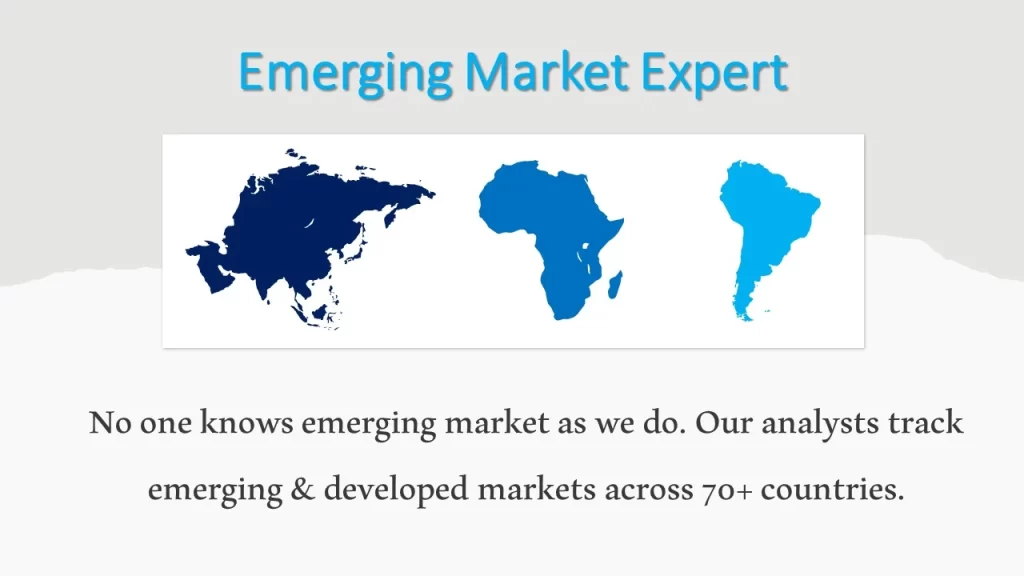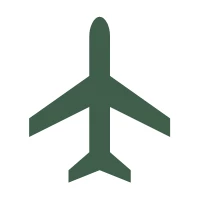Anti-Drone Market Size, Share, Trends and Growth Report – Global Opportunities & Forecast, 2023-2030
GMI Research analysis indicates that the Anti-Drone Market size was estimated at USD 1.3 billion in 2022 and is slated to register a double digit CAGR of 25.9% over the period 2023-2030 and is projected to reach USD 8.2 billion in 2030.
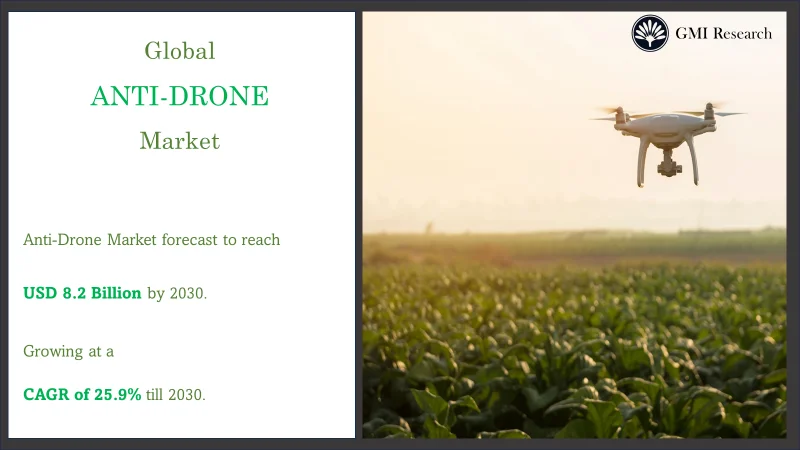
Major Anti-Drone Market Drivers
The anti-drone market is predicted to grow more significantly due to the growing adoption of directed energy arms to counter and neutralize threats including mortar-launched explosives, rockets, aerial threats, and drones. Growing investment in military and defense intelligence segments, along with technological innovations in laser-based target-focused arms, is contributing to the global anti-drone market growth. Also, the anti drone market is driven by the growing occurrence of security breaches in critical infrastructure by unlawful drones. Furthermore, the industry is expanding due to the growing embrace of aerial remote sensing technologies aimed at preventing critical infrastructure.
The significant increase in the international usage of Unmanned Aerial Vehicles (UAVs) for promotional and entertainment determinations has led to substantial growth in incidents connected to public security damages. The identification and documentation of these drones have significantly contributed to security management activities, thereby fostering the anti-drone system market. Moreover, in research and development activities U.S. has made a significant number of investments concerned with anti-drone systems which made it a forerunner in the anti-drone market. For instance, during 2020, the U.S. Department of Defense got a reward of $106 million contract to Anduril Industries for its anti-drone system, SkyDrone. This system is designed to identify and offset unauthorized drones, offering military installations a robust defense against potential warnings from hostile drones.
Sample Request
To have an edge over the competition by knowing the market dynamics and current trends of “Anti-Drone Market” request for Sample Report here
Furthermore, China has bolstered its capabilities in anti-drone technology, specifically aiming at mitigating potential threats predicted by drones, including those with unlawful objectives. China has made rapid advancements in different factors of defense technology, with a notable aim of strengthening its anti-drone capabilities. This progress reflects the nation’s commitment to developing all-inclusive solutions that address the continually evolving insight of security threats and propelling growth. However, different systems employ different methods for drone detection. Different approaches for drone detection and diagnostics methods include Electro-optical detection, Radar-based detection, radio-frequency detection, and infrared radiation. The rapid usage of RF jamming, interrupting signals between drones, and their base nodes, leading to communication blockage, is gaining prominence. The growing need for RF jamming solutions to impede the movements of drones in unlawful airspaces fosters the global anti drone market.
While the counter-drone systems are predominantly integrated into military and defense projects. Governments globally employ different counter-UAV solutions based on different technologies. These systems are often expensive and subject to stringent government regulations. However, nations have uncommon drone regulations, there is a shortage of standardization in technologies. Systems are typically classified based on how they detect a drone or radars, their actions after detection (drone collision, nets, lasers, microwave attack, and RF jamming,) and their platform (handheld, mounted, mobile, and ground).
Request Research Methodology
Do you want to know more about the Research process and detailed Methodology, Request Research Methodology of this report
The regulatory landscape for counter-drone technologies remains unclear, especially for airports and local law enforcement agencies. The evolving nature of drone technology poses challenges in defining and implementing comprehensive regulations in these domains. Detection methods for thwarting UAV functions often involve working in the radio frequency spectrum, which can potentially pose risks to manned aircraft and impact surveillance, navigation signals, and communications used by air traffic control. Consequently, these systems could harm aviation rules and regulations, functioning as a restriction for the market.
Whereas, producers have notably scaled up their production capacity to meet the mounting demand for anti-drone systems coupled with the growing prevalence of UAVs is estimated to increase government safety concerns, driving the global anti-drone market share. Governments frequently deploy standby and missile air force fighters as part of their air defense strategies against drones. However, missiles and fighter jets may be less effective against threats from small drones and UAVs. To counter such threats, governments and companies around the globe are progressively investing in the development and promotion of anti-UAV technology. Manufacturers are integrating different approaches for drone detection into their anti-UAV systems to develop their comprehensive performance which further presents a positive impact on global anti-drone market.
Request for Customization
In case, any of your pain points areas are not covered in the current scope of this report, Request for Customization here
By Vertical, Military and Defense segment accounts for the largest market share in the global anti-drone market
The substantial rise in prohibited and terrorism globally, encompassing illegal smuggling and border crossing, is anticipated to boost the implementation of anti-UAV programs among international security arms. The increased funding in research and development by leading contractors of defense, and the growing positioning of anti-UAV programs by different military arms to protect against potential risks, drives the military and defense segment growth. Moreover, incidents such as border crossing, smuggling, attacking military structures, and others have foster the research and development of sophisticated Counter-Unmanned Aircraft Systems capable of recognizing, disabling, tracking, drones, and simultaneously positioning their operators. A substantial portion of defense budgets is being allocated to facilitate the research and development in developing such systems. Different armed forces are actively developing their counter-drone capabilities. In 2021, the Japanese Ministry of Defense allocated a budget of USD 20 million for the research and development of Counter-Unmanned Aircraft Systems technology. Precisely, the MoD allocated USD 4.8 million for researching microwaves for potential utilization in a C-UAV system. Such advancements are predicted to propel the global market in the forecast period.
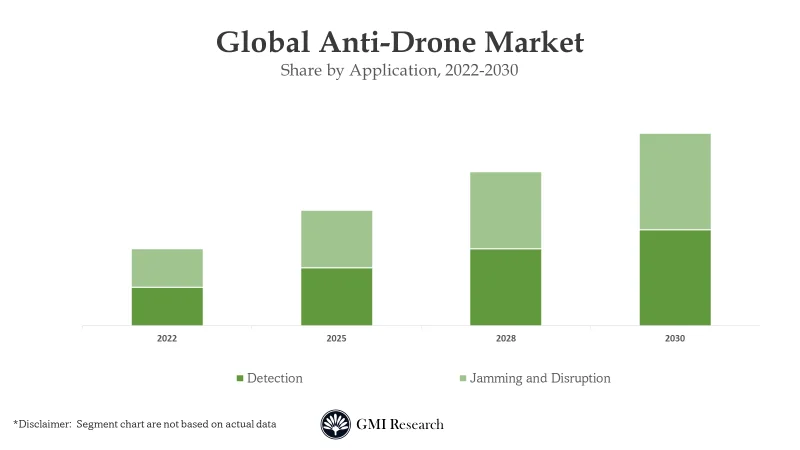
By Platform, UAV-based segment is anticipated to rise at the fastest rate in the global anti-drone market in the forecast period
The UAV-based segment is fostered by the necessity for countermeasures against unlawful or possibly malicious objects. The potential to deploy countermeasures from UAVs allows for more variable and effective responses to drone risks, thereby pushing complete safety measures. Moreover, the growing usage of improved combat drones for thwarting other drones and the rising military finances assigned for attaining such effective drones are expected to propel the demand for these solutions.
By Region, the Asia Pacific region is the speediest-rising region for the global anti-drone market
The regional growth is attributed to a significant rise in government spending for enhancing the infrastructure of defense and innovation in aviation in different nations, mainly India, and China. A number of organizations and institutions around the Asia Pacific region, such as the Beijing Institute of Technology, NovaSky, and China National Nuclear Corporation are forming strategic partnerships to aim for research and development to battle the UAS technology, which advances APAC anti-drone market size. In 2021, the Indian Navy agreed on a contract with Bharat Electronics Limited to procure naval counter-drone systems. This marks the first induction of such a system by the Navy, capable of promptly detecting, and jamming micro drones, and utilizing a laser-based kill mechanism to neutralize the target.
Asia Pacific is a region marked by significant political disputes, promoting countries around the area to constantly update their security solutions and arms. For instance, China, during a political difference with India, has begun making efforts to strengthen its energies and improve the infrastructure of defense. Additionally, the rise in security systems at airports and the prevention of international borders around the APAC region are anticipated to present a positive impact on the market.
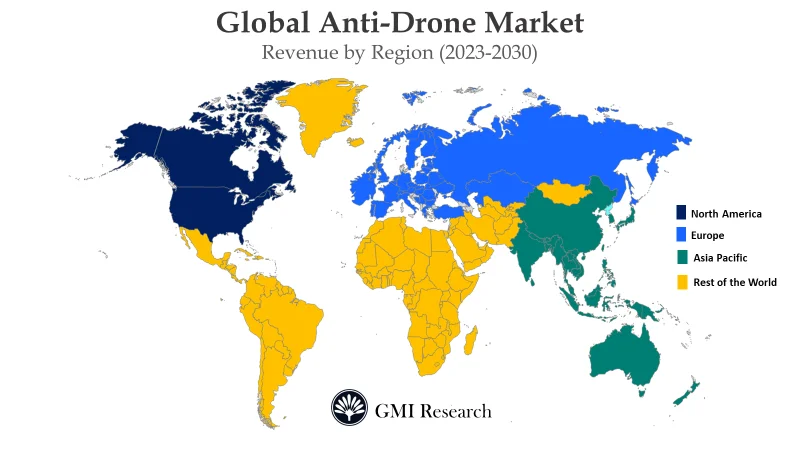
Top Market Players
Various notable players operating in the market include RTX, Lockheed Martin Corporation, Leonardo S.p.A., Thales, IAI, Rafael Advanced Defense Systems Ltd., Blighter Surveillance Systems Limited, DroneShield Ltd, Dedrone among others.
Sample Request
For detailed scope of the “Anti-Drone Market” report request a Sample Copy of the report
Key Developments
-
- In 2023, DroneShield launched an Area-Specific Satellite Denial System to develop its portfolio and defeat potential within its products.
- In 2023, Swedish Defense Material Administration signed a contract with Thales to deliver and installation of Smart-L Multi-Mission which are land-based long-range radars.
- In 2023, Leonardo successfully launched two new turrets for land and naval defense to enable protection from almost all varieties of asymmetric threats such as helicopters, and drones, within an intricate scenario with multiple or several targets.
- In 2023, Cognex Corporation launched an In-Sight Vision System which offers processing speed double that of prior systems and delivers integrated solutions for a broad range of scrutiny applications.
- In 2023, Dedrone launched a 6.0 version of DedroneTracker.AI to enable autonomous threat recognition and classification capabilities required by their most strategic clients.
Segments covered in the Report:
The Global Anti-Drone Market has been segmented on the basis of Application, Vertical and Platform Type. Based on the Application, the market is segmented into Detection, The Detection Segmented into RADARs & Other Sensors and Jamming and Disruption. Based on the Vertical, the market is segmented into Military and Defense, Airports and Others. Based on the Platform Type, the market is segmented into Ground-based Handheld and UAV-based
|
Report Coverage |
Details |
| Market Revenues (2022) |
USD 1.3 billion |
| Market Base Year |
2022 |
| Market Forecast Period |
2023-2030 |
| Base Year & Forecast Units |
Revenues (USD billion) |
| Market Segment | By Application, By Vertical, By Platform Type, By Region |
| Regional Coverage | Asia Pacific, Europe, North America, and RoW |
| Companies Profiled | RTX, Lockheed Martin Corporation, Leonardo S.p.A., Thales, IAI, Rafael Advanced Defense Systems Ltd., Blighter Surveillance Systems Limited, DroneShield Ltd, Dedrone., among others; a total of 9 companies covered. |
| 25% Free Customization Available | We will customize this report up to 25% as a free customization to address our client’s specific requirements |
Market Segmentation
Global Anti-Drone Market By Application
-
- Detection
- RADARs
- Other Sensors
- Jamming and Disruption
- Detection
Global Anti-Drone Market By Vertical
-
- Military and Defense
- Airports
- Others
Global Anti-Drone Market By Platform Type
-
- Ground-based
- Handheld
- UAV-based
Global Anti-Drone Market by Region
-
-
North America Global Anti-Drone Market (Option 1: As a part of the free 25% customization)
- By Application
- By Vertical
- By Platform Type
- US Market All-Up
- Canada Market All-Up
-
Europe Global Anti-Drone Market (Option 2: As a part of the free 25% customization)
- By Application
- By Vertical
- By Platform Type
- UK Market All-Up
- Germany Market All-Up
- France Market All-Up
- Spain Market All-Up
- Rest of Europe Market All-Up
-
Asia-Pacific Global Anti-Drone Market (Option 3: As a part of the free 25% customization)
- By Application
- By Vertical
- By Platform Type
- China Market All-Up
- India Market All-Up
- Japan Market All-Up
- Rest of APAC Market All-Up
-
RoW Global Anti-Drone Market (Option 4: As a part of the free 25% customization)
- By Application
- By Vertical
- By Platform Type
- Brazil Market All-Up
- South Africa Market All-Up
- Saudi Arabia Market All-Up
- UAE Market All-Up
- Rest of world (remaining countries of the LAMEA region) Market All-Up
-
Global Anti-Drone Market Players (Option 5: As a part of the free 25% Customization – Profiles of 5 Additional Companies of your Choice)
-
- RTX
- Lockheed Martin Corporation
- Leonardo S.p.A.
- Thales
- IAI (Israel Aerospace Industries)
- Rafael Advanced Defense Systems Ltd.
- Blighter Surveillance Systems Limited
- DroneShield Ltd
- Dedrone
Related Reports
- Published Date: Nov-2023
- Report Format: Excel/PPT
- Report Code: UP3575-001001
Licensing Options
Single-User License:
The report is used by the purchaser (One Individual) only
Multi-User License:Report is shared with maximum 5 users (employees) including the purchaser of the purchasing corporation only
Corporate License:
Report is shared with unlimited user (employees) of the purchasing corporation only
The report is used by the purchaser (One Individual) only
Multi-User License:Report is shared with maximum 5 users (employees) including the purchaser of the purchasing corporation only
Corporate License:
Report is shared with unlimited user (employees) of the purchasing corporation only
Anti-Drone Market Size, Share, Trends and Growth Report – Global Opportunities & Forecast, 2023-2030
$ 4,499.00 – $ 6,649.00
Why GMI Research


